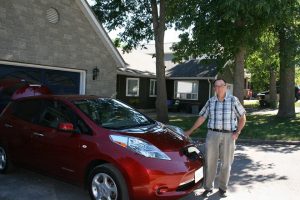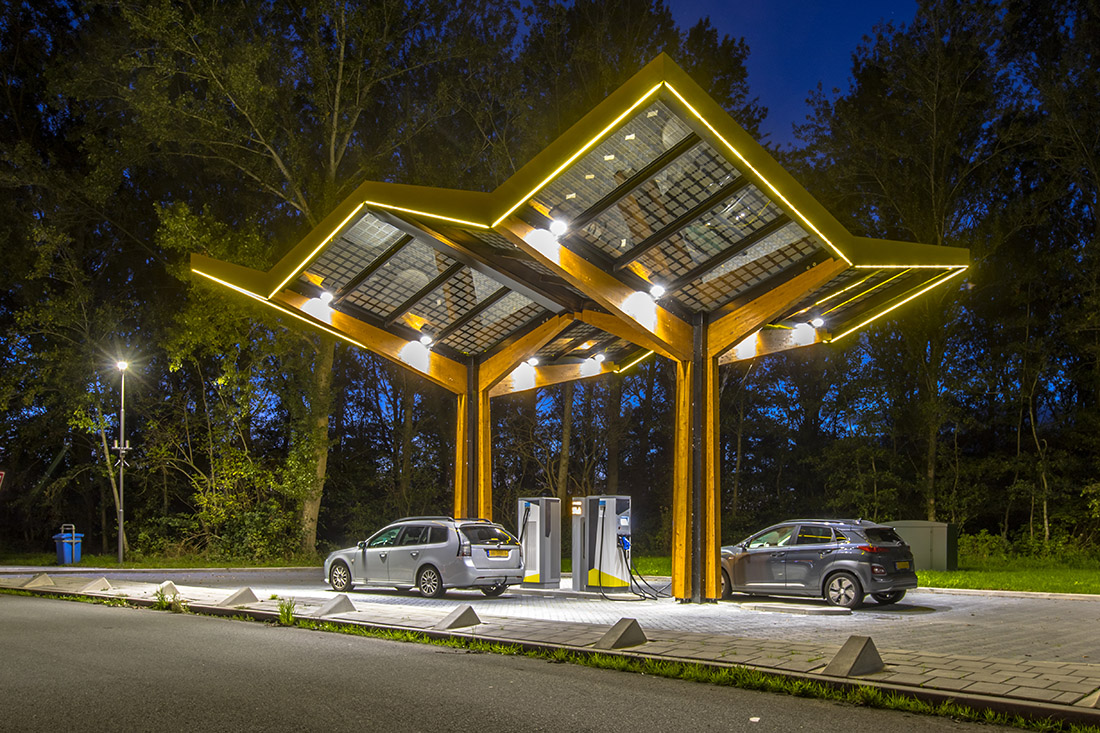by Dave Vanalstyne, EV owner
 On Saturday and Sunday, September 28-29, 2019 the Orillia Square Mall will be the home of Orillia’s first “EV Weekend.” Members of the Electric Vehicle Society of Ontario, Tesla owners, PlugnDrive — all will be there to welcome drivers interested in knowing more about owning an all-electric vehicle.
On Saturday and Sunday, September 28-29, 2019 the Orillia Square Mall will be the home of Orillia’s first “EV Weekend.” Members of the Electric Vehicle Society of Ontario, Tesla owners, PlugnDrive — all will be there to welcome drivers interested in knowing more about owning an all-electric vehicle.
If you’re interested in owning an electric car, but don’t know where to get honest, independent advice about what the switch involves, one of the best places you can start is to talk to members of the “Electric Vehicle Society” — Ontario’s largest EV owners’ group.
It was founded in August of 1994 at a time when the only electric cars available were handcrafted one-offs. Today, members of the group help to organize education and test drive events like the Electric Vehicle Weekend coming up in two weeks. As a not-for-profit organization, it is our mandate to work with groups like Sustainable Orillia who are spearheading local initiatives to accelerate the adoption of electric vehicles and shift car culture towards a more environmentally sustainable future. Representing over 1000 electric vehicle owners, the Ontario EV Society conducts Regional Chapter meetings, community outreach events, public presentations to community and school groups, advisory sessions with municipalities on fleet greening, and participates in government consultations.
The best ambassadors for EVs are those who already own an electric car, and we are pleased to announce that a new Chapter of the EV Society was formed this year in Orillia-Barrie as one of the 12 chapters spread across Ontario. To date 90% of Ontario’s population is within Chapter boundaries. As the Chapter lead for the new Barrie-Orillia Chapter and a resident of Orillia, I am delighted with the response we have had from EV owners since beginning monthly meetings in Barrie – and I welcome anyone who has an EV or is interested in learning about them to come and join us.
If you ask most people what name they think of when the subject of an electric vehicle comes up, the usual answer is “Tesla,” a brand that has raised the bar on what to expect in an electric vehicle. The reality, though, is that there are up to 50 all-electric (EV) and plug-in hybrid (PHEV) models on the market to chose from. Currently, prices range from around $36,000 for a Kia Soul EV to $175,000 for a Tesla Model X P100D. IN spite of these costs, there are already 34,000 electric vehicles on the roads of Ontario.
As an owner of a 7-year-old, electric Nissan Leaf, I am adamant that I will not go back to gas. The car is fun to drive and when you add “economical” and “inexpensive” it is a great option for my in-town driving. I do not miss oil and filter changes, rad flushes, fan belt replacements and other maintenance requirements of gasoline-powered vehicles—none of which are needed with an EV.
It is this lower operating cost that causes industry analysts to predict major disruptions in the transportation industries. Consider the impact of on-demand, electric, autonomous vehicles (Uber without the need for a driver) and the inevitable reduction in costs. It is quite possible that there is a future ahead where far fewer people will even need to own their own cars – especially in cities.
The one question I get asked the most is, “How do you charge it up and how far can you go with it?” Today’s EV and PHEV owner has the option of charging at home on a regular 120 volt household plug (the slowest method, known as a Level 1) or installing a 240 VAC Level 2 charger (much quicker than Level 1). EV owners like myself will plug into a Level 2 charger in our garages after 7 p.m. when the hydro rates are at their lowest.
The original Nissan Leaf made its debut in Canada in 2011 with a 24 kWh battery and only about a 100km range, but batteries and ranges have improved since then. Battery density has risen, the sizes have shrunk and the capability to store energy has improved. The 2019 Leaf S Plus comes with a respectable 62 kWh battery with a range of up to 363 km on a single charge.
While batteries improve, prices drop and ranges increase, charging locations also multiply. There are now over 2,500 Level 2 chargers in Ontario located in public parking garages, car dealerships, public parks and at business that want to attract future customers. More are being installed daily.
In addition, there are at least 750 high-powered Level 3 chargers in the province and that number is growing. These chargers are capable of delivering enough power at 200 – 600 volts to bring a vehicle battery up to 80% of a full charge in as little as 30 minutes.
When traveling I have found that many hotels and businesses are willing to allow an EV driver to plug into an outdoor outlet with the on board cord-set for a level 1 charge when a level 2 or 3 charger is not available so you can recharge no matter where you are.
The point of all this? With some route planning and guidance from websites that help the traveller locate chargers, there are few places today that you can’t reach with an EV or PHEV.
Along with the growing public awareness of the benefits of BEV and PHEV ownership, the EV Society believes that, in spite of the nay-sayers, they are already practical for many–if not most—people to drive.
With the knowledge gained from speaking to EV owners, a new car buyer can now walk into a dealership confidently deciding to go with an electric vehicle.
But then again, he or she will still spend most of their decision-making time on the colour choices!
See you at Orillia Square Mall on EV Weekend!
Further Information
Visit https://www.autotrader.ca/newsfeatures/20190405/every-electric-vehicle-and-plug-in-hybrid-available-in-canada-in-april-2019/ for a list of EV and PHEV available in Canada.
Visit https://www.plugshare.com or https://chargehub.com for charging station locations.
Visit https://evsociety.ca for further information about the society.

